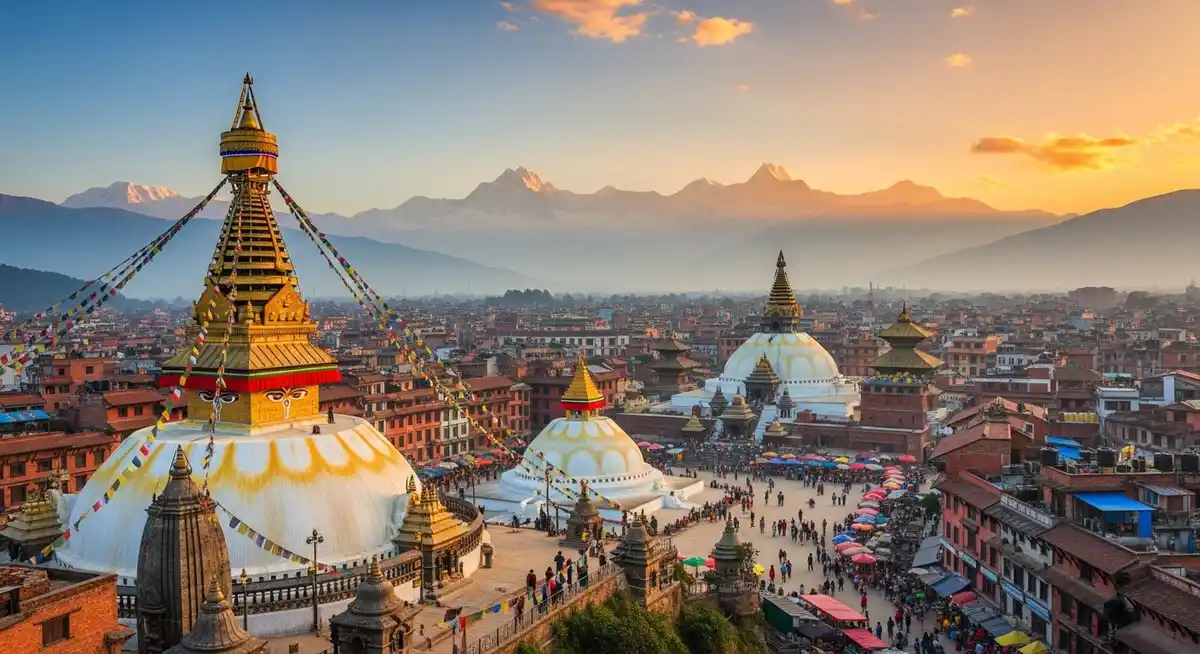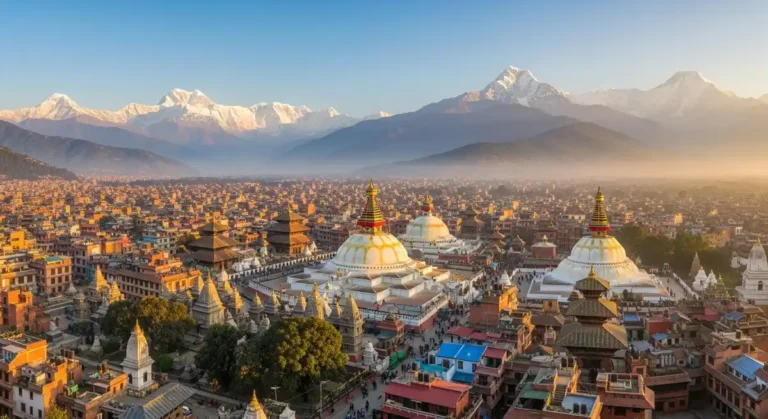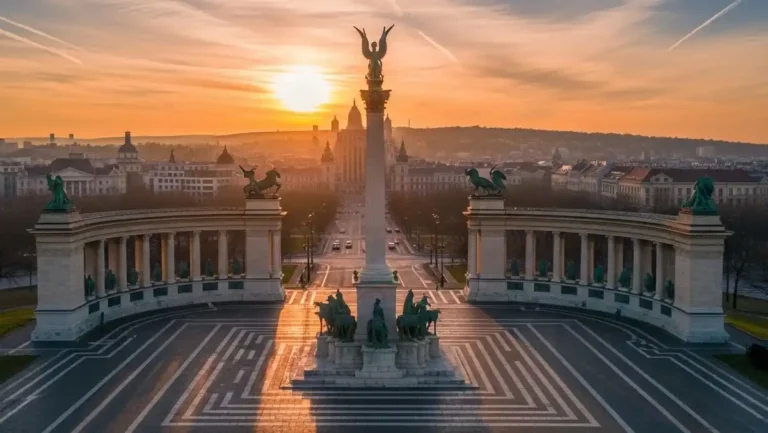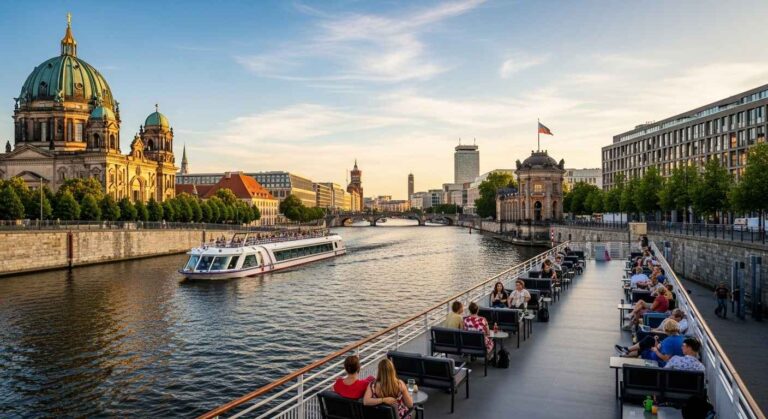What is Kathmandu Famous For? Love at First Sight
Kathmandu is famous for its ancient Hindu and Buddhist cultures, UNESCO World Heritage sites like Boudhanath Stupa, Pashupatinath Temple, and Durbar Squares, along with its rich architecture, vibrant markets, and its role as the gateway to the Himalayas for treks and Everest expeditions.
Here’s a concise summary of the key points from the full content:
- Cultural & Historic Center – Kathmandu blends Hindu and Buddhist traditions, enriched by Newar culture, festivals, and vibrant daily street life.
- UNESCO World Heritage Sites – Home to Swayambhunath (Monkey Temple), Boudhanath Stupa, Pashupatinath Temple, and the Durbar Squares of Kathmandu, Patan, and Bhaktapur.
- Architecture & Arts – Famous for Newar wood carvings, metalwork, and pagoda-style temples, with living traditions like the Kumari (Living Goddess).
- Festivals & Traditions – Celebrations such as Indra Jatra, Dashain, and Tihar bring rituals, processions, and cultural performances to life.
- Food Culture – Known for Dal Bhat, momos, Newari specialties (chatamari, yomari, juju dhau), and street snacks, along with lively tea-houses and cafes.
- Markets & Lifestyle – Thamel and local bazaars offer handicrafts, trekking gear, art, and nightlife, blending tradition with modern city vibes.
- Gateway to the Himalayas – Main hub for trekking, Everest expeditions, and Himalayan adventures, with Lukla flights and trekking logistics starting here.
- Population Growth – Rapidly expanding city and valley, now the most populous urban hub in Nepal with around 4 million in the greater metropolitan area.
- Tourism & Accessibility – Strong infrastructure with an international airport, hotels, guides, and services for travelers, including accessible options.
Kathmandu, the cultural and political center of Nepal, is a historic city with a unique blend of Hindu and Buddhist cultures.
Walking through the bazaars and markets, one can feel the vibrant life of the local restaurants, festivals, and street food.
The Newar culture adds depth to the monuments, squares, and heritage sites, making them more than just significant sites—they feel alive with tradition.
The city is home to UNESCO World Heritage sites such as the Swayambhunath, Boudhanath Stupa, Pashupatinath Temple, and the Durbar Squares.
These landmarks highlight the rich architecture and ancient traditions that continue to inspire visitors from all over the world.
Beyond the city, Kathmandu offers proximity to the majestic Himalayan foothills, attracting trekkers and mountaineers who come for Himalaya treks and Everest expeditions.
With the international airport located here, the city is the gateway for any trip across Nepal, whether toward Pokhara or the rural regions.
Experiencing the perspective of both city life and mountain landscapes makes Kathmandu truly unforgettable.
What is Kathmandu Known For?
Kathmandu is known for its rich history, UNESCO World Heritage Sites, sacred temples, and vibrant culture.
The capital of Nepal is also a gateway to the Himalayas, famous for trekking, mountaineering, and its unique blend of traditions and modern life.
The Kathmandu Valley is filled with cultural landmarks and historic sites that tell stories from the Licchavi period.
Walking through Durbar Squares in Kathmandu, Bhaktapur, and Patan, you see royal palaces, pagoda-style temples, and impressive architecture.
These places reflect the city’s long history and its role as a political, cultural, and economic hub of Nepal.
The Sacred Sites and Temples are unforgettable. The Swayambhunath, also called the Monkey Temple, and the grand Boudhanath Stupa are important Buddhist stupas.
The Pashupatinath Temple, a holy pilgrimage site for Hindus, shows how Hinduism and Buddhism live side by side.
These religiously significant sites are part of what makes the city so meaningful to travelers from all over the world.
Food and daily life add another layer to the city’s charm. You can enjoy street food like a cool lassi, or taste traditional Newari meals such as dal bhat.
The lively markets in Thamel are filled with handicrafts, fair trade goods, and many culinary delights. This creates a vibrant atmosphere where traditions and modern life blend together.
Beyond the city, Himalayan adventures call. The Everest range is just a flight away, leading to famous treks like the Everest Base Camp.
The Himalayas make the capital a true Himalayan Gateway for trekkers and mountaineers.
Nature lovers can also explore the Garden of Dreams or Shivapuri Nagarjun National Park, enjoying the region’s natural beauty.
Kathmandu remains a center where culture, history, and adventure meet. Its bustling streets, timeless traditions, and role as a trade hub make it a destination that stays in every traveler’s heart.
Kathmandu Population
The city of Kathmandu has seen strong growth over time. From a small town of 104,479 people in 1950, it has become a busy center with an estimated population of 1,672,900 in 2025.
Reports from the UN World Urbanization Prospects and its latest revision confirm this steady annual change.
The urban agglomeration, which also covers suburban areas, adds to these rising numbers.
The 2021 Nepal census showed 845,767 residents and 105,649 households inside the city. The Metropolitan City itself was home to 862,400 people.
Some sources present a projected figure of 1,442,271 for 2025, while other estimates for the greater urban area reach around 1.5 million.
By 2022, the city was already marked at 1.521 million. The valley area and the surrounding metropolitan area have grown too, with close to 4 million residents, showing how vibrant and important Kathmandu has become.
Population Highlights
- 1950 – 104,479
- 2021 Nepal census – 845,767 (105,649 households)
- 2021 Metropolitan City – 862,400
- 2022 estimate – 1.521 million (city)
- 2025 projected figure – 1,442,271 (urban area)
- 2025 estimate – 1,672,900 (citywide)
- Greater valley & surrounding metropolitan area – about 4 million
Population of Kathmandu Valley 2078 (Nepali calendar)
In 2078 BS, the Nepali census recorded the population with detailed reports. The Kathmandu metropolitan city reached 2,041,587 residents, showing a significant increase compared to previous counts.
This made the city not only the most populous city in Nepal but also the one with the highest population density.
Looking at the overall picture, the Kathmandu Valley, which includes the city itself and its surrounding areas, reached approximately 2,996,341 people.
This Wikipedia estimate, supported by official data, shows how lively and growing the Valley has become.
The Census Year was 2078 BS (2021 CE), when the National Population and Housing Census collected the official figures.
The trusted Census Authority, the National Statistics Office of Nepal, confirmed these Key Details.
With this context, the population density of the Kathmandu Valley (Estimated) stands as the highest in the country, reflecting its role as a center of culture, history, and daily life.
What is Kathmandu Famous for in Nepali
Kathmandu is famous in Nepali for its UNESCO World Heritage Sites, ancient temples, stupas, and palaces.
It is also known as a vibrant hub of Hindu and Buddhist cultural heritage, a lively center of street life, and the Gateway to the Himalayas for trekkers and adventure tourism.
The city of Kathmandu is the heart of Nepal, full of ancient wonders and cultural treasures.
It is the home of seven UNESCO World Heritage Sites, including the Durbar Squares, Swayambhunath Monkey Temple, the Boudhanath Stupa, and the Pashupatinath Temple.
Each of these places boasts a rich and unique heritage that showcases the blend of Hindu and Buddhist faiths.
The Valley is a historical tapestry where traditions and modern life come together in harmony.
In my visits, I enjoyed the lively atmosphere of Thamel, a bustling center where markets are filled with diverse cuisine and warm hospitality.
The streets are full of color, music, and daily life, making the city always vibrant and inviting. Beyond culture, Kathmandu is also a Gateway to the Himalayas.
It is the starting and endpoint for trekking expeditions to the Everest region and other parts of the mountains, truly a mecca for adventure tourism and travelers.
The hub is always serving explorers, making journeys possible in the world’s highest peaks.
Top 12 reasons Kathmandu is famous
1. UNESCO World Heritage sites & Durbar Squares (Kathmandu, Patan, Bhaktapur)
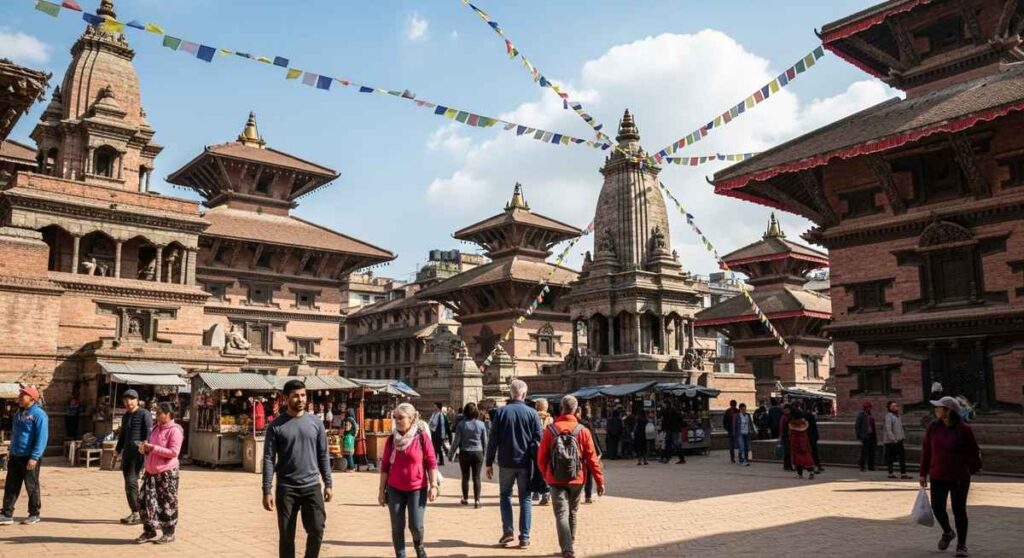
The UNESCO World Heritage sites & Durbar Squares (Kathmandu, Patan, Bhaktapur) are treasures of the Kathmandu Valley, showcasing palaces, temples, courtyards, and ancient structures built by the Newar community.
Each square—Kathmandu Durbar Square, Patan Durbar Square, and Bhaktapur Durbar Square—highlights cultural heritage, artistic achievements, and the medieval past of Nepal.
The Kathmandu Valley is home to seven groups of monuments and buildings called monument zones.
These include Buddhist stupas like Swayambhu and Bauddhanath, and Hindu temples such as Pashupati and Changu Narayan.
Together, they form a UNESCO World Heritage Site, admired for its cultural heritage, artistic achievements, and architectural heritage.
In Kathmandu Durbar Square, the Hanuman Dhoka palace, Taleju Temple, and Kumari Ghar (the House of the Living Goddess) shine as symbols of royal squares.
Visitors experience shrines, regal history, and a vibrant cultural life at this cultural landmark.
The Patan Durbar Square in Lalitpur stands out for its ancient structures, including the Krishna Mandir and the Patan Museum.
With its Buddhist and Hindu religious structures, it reflects Newari artistry, religious diversity, and houses fine cultural artifacts.
Bhaktapur Durbar Square is admired for its medieval atmosphere. The 55-Window Palace, the Nyatapola Temple (the tallest pagoda-style temple), and the Fasidega Temple offer amazing views of the eastern part of the square.
The legacy of the Malla dynasty, their palaces, and the stories of rival kingdoms remain visible in every city—Kathmandu, Patan, and Bhaktapur—making the valley a living gallery of history.
2. Pashupatinath (major Hindu pilgrimage & cremation ghats)

Pashupatinath (major Hindu pilgrimage & cremation ghats) in Nepal is a UNESCO World Heritage Site on the banks of the Bagmati River in Kathmandu.
It is the earthly abode of Lord Shiva, famous for its pagoda-style temple, sacred cremation ghats, and vibrant festivals like Maha Shivaratri, making it one of the holiest Hindu pilgrimage destinations.
In the heart of Kathmandu Valley, the Pashupatinath temple stands as a sacred destination for Hindus.
Known as the earthly abode of Lord Shiva, this World Heritage Site is admired for its golden plated exterior, silver doors, and graceful pagoda architecture. The temple is a symbol of spiritual life, peace, and devotion.
The vast temple complex spreads over many hectares and is filled with monuments, statues, and sculptures of stone, metal, and wood.
Visitors can see carved gates, pillars, and detailed shapes of divinities and griffins.
It feels like an open museum, where historians admire the art and architecture, while pilgrims come to perform rituals, participate in ceremonies, and immerse themselves in the sacred atmosphere.
The Arya Ghat and Surya Ghat are primary components of the cremation ghats on the holy river. Here, ceremonies are carried out with traditional practices.
This part of the complex reflects the deep cultural and spiritual significance of the site, making it a focal point of Hindu spirituality.
Nearby, the Shleshmantak forest adds to the charm with deer and monkeys, showing the harmony of nature and faith.
Throughout the year, many festivals take place, but Maha Shivaratri is the most significant, drawing thousands of devotees.
The temple is also honored as one of the Jyotirlingas and is connected to ancient texts like the Skanda Purana, Tevaram, and the Mahabharata legend.
The linga of Shiva here is believed to be a sacred manifestation, fulfilling wishes of the faithful.
The sacred complex is linked with holy sites across India like Kashi Vishwanath, Kedarnath, Rudranath, Kalpeshwar, Madhyamaheshwar, and Tungnath.
The traditions are preserved by Vedic Dravida Brahmins from Karnataka, trained at Sringeri Sharada Peetham in Southern India.
The Pashupati Area Development Trust (PADT), formed under the initiative of King Birendra Bikram Shah Dev, ensures protection of its cultural, historical, and natural resources, keeping this extensive precinct alive for future generations.
3. Boudhanath Stupa (Tibetan Buddhist hub)
The Boudhanath Stupa is a sacred site of Tibetan Buddhism in Kathmandu, Nepal. Recognized as a UNESCO World Heritage Site, this massive and spherical stupa is seen as a spiritual landmark and the heart of Tibetan culture in exile.
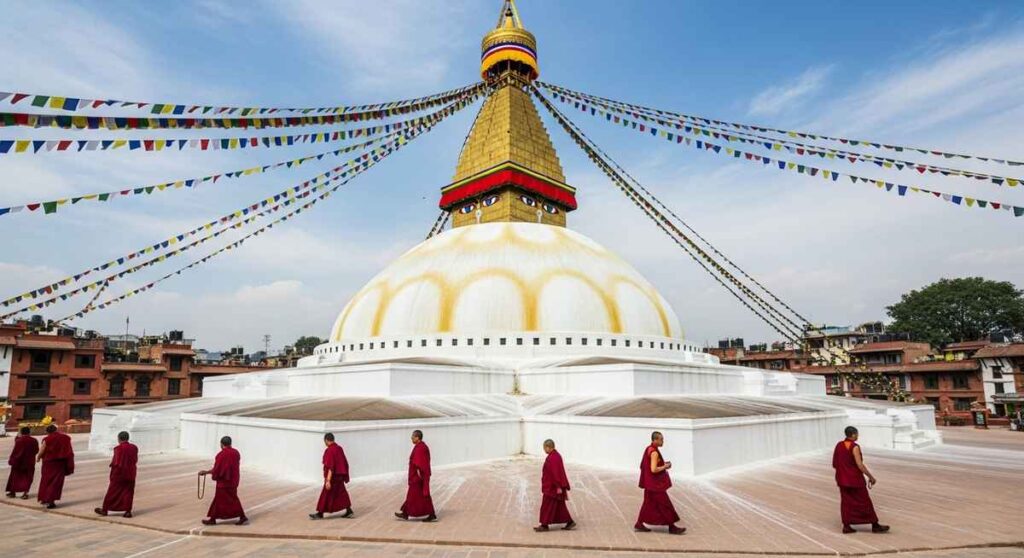
Its painted Buddha eyes on the harmika tower look across the Valley, sharing a message of wisdom and enlightenment.
Also called Boudha Stupa, Khasti Chaitya, or Khāsa Chaitya, it is known in Nepali as बौद्धनाथ and in Newari as खास्ति चैत्य.
Ancient texts mention names like Jarung Kashor, written in Standard Tibetan (བྱ་རུང་ཁ་ཤོར།) and in Wylie (bya rung ka shor).
Built among rice paddies in the Kathmandu Valley, its mandala symbolizes the universe. The dome, golden spire, and stupa umbrella with thirteen stages represent the path to enlightenment.
Inside the Boudanath, holy relics such as those of Kassapa Buddha, Shakyamuni Buddha, and other Dharmakaya, Dharma, Cloth, Body, Speech, Mind, Qualities, and Activity relics are kept.
For centuries, Tibetan merchants on the old trade route from Tibet to India stopped here for prayers.
The route passed Sankhu, Chabahil with the Charumati Stupa or Little Boudhanath, and then crossed the Bagmati River to Lalitpur and the Malla Kingdom of Patan.
Nearby, the Statue of Padmasambhava, the founder of Tibetan Buddhism, stands in Ghyoilisang peace park.
Around the stupa are Prayer wheels inscribed with the mantra of Avalokiteshvara, Om mani padme hum.
The area grew into a center of gompas, Buddhist monasteries, restaurants, guesthouses, and artisanal businesses, making it a lively hub for both Buddhists and tourists.
Along with Swayambhunath and Namo Buddha, it is one of Nepal’s most important pilgrimage sites.
At the northern entrance, a shrine honors the Dharma protectress Mammo Pukkasi, known locally as Hariti or Ajima by Newari Buddhists.
The Ganachakra offerings here are cared for by the Mahaguru Gompa.
The architectural wonder of Boudhanath Stupa continues to be an enduring spiritual icon, with colorful prayer flags or lungta carrying mantras, blessings, and positive energy across the globe.
4. Swayambhunath (Monkey Temple) — panoramic views & syncretic worship
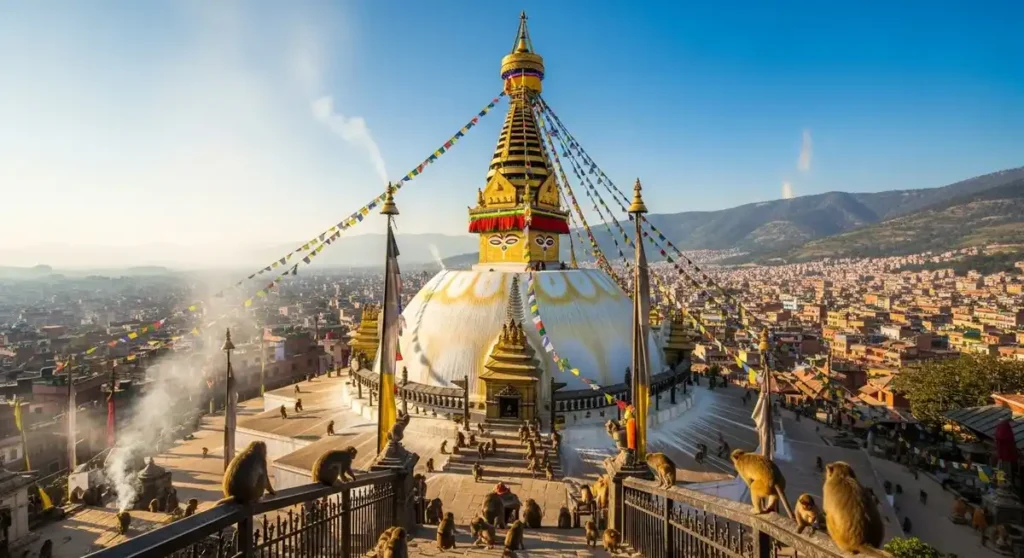
High above the Kathmandu Valley, the Swayambhunath Stupa—also called Swoyambhu or Swayambu—shines with its white dome and the watchful eyes of Buddha.
The air is filled with the smell of incense and the sound of soft chanting, while friendly monkeys play near the sacred shrines. It is a place where visitors find inner peace and feel close to cosmic wisdom.
The temple is one of the most ancient and deeply religious landmarks of Nepal. People of both Hinduism and Buddhism gather here, showing true harmony.
Beautiful architecture, carvings of deities, and the rich traditions of Newar Buddhism and Vajrayana make the site special.
For Tibetans and followers of Tibetan Buddhism, it holds the same importance as Boudha.
Recognized as a UNESCO World Heritage Site, Swayambhunath is linked to many great teachers, including Koṇāgamana Buddha, Kakusandha Buddha, Kassapa Buddha, and Gautama Buddha.
In Nepal Bhasa, it is known as a sacred place where pilgrims climb the stone steps in devotion. The site is full of iconography and the lasting presence of Gautama, making it a central space for Buddhist pilgrimage.
Walking around the stupas, shrines, and temple, one can feel the spiritual depth of this place. With monkeys running across the pathways, the energy remains full of joy.
In every corner of Swoyambhu, the balance of cosmic faith, Buddha, and cultural harmony shines bright, making it a heart of spirituality in Nepal.
5. Newari cuisine & street food (momos, chatamari, yōmari, dal bhat)
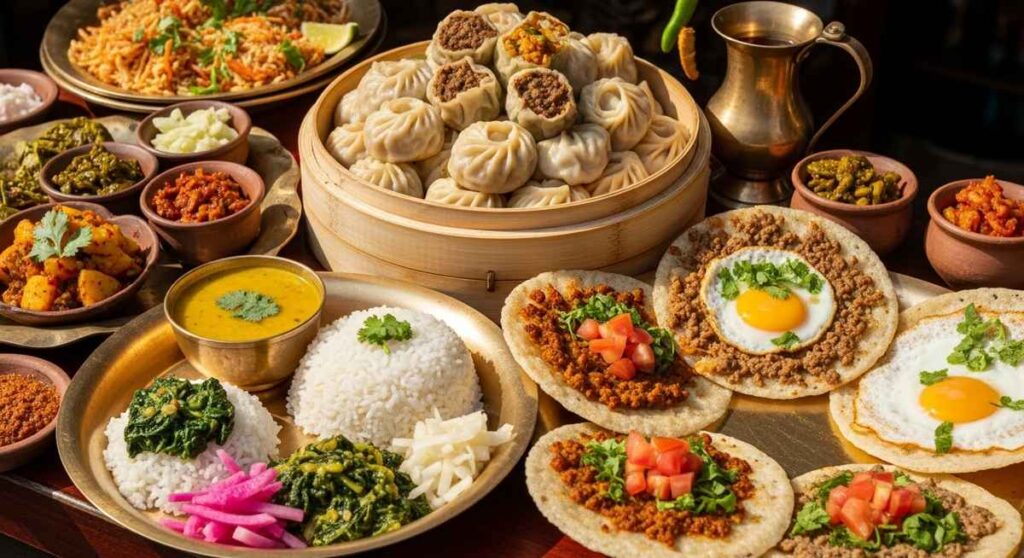
Dal Bhat
A classic staple meal of Nepal made of steamed rice (bhat) and lentil soup (dal). It often comes with vegetables, pickles, and sometimes meat. Nutritious and satisfying, this national dish is eaten daily by many.
Momos
Soft dumplings filled with meat, vegetables, or a combination of both. They can be steamed or fried and are served with spicy dipping sauces like achar or chutneys. A true flavorful snack or meal, momos are a popular street food across Kathmandu.
Chatamari
A Newari specialty often called the Newari pizza. Made from rice flour crepe, it is topped with eggs, yak cheese, ground meat, onions, tomatoes, and chillies. Sometimes served open-faced or folded like a taco, it is a savory appetizer loved in the Kathmandu Valley.
Yomari
A celebratory dumpling made of rice flour and filled with sesame seeds, molasses, coconut, or sugar cane. It is a delicacy enjoyed during the Yomari Punhi festival, which marks the rice harvest. Its sweet steamed taste makes it both cultural and festive.
Other Newari Foods
- Samay Baji: A ceremonial platter with beaten rice, spiced buffalo meat, and other condiments.
- Choila: Spicy grilled meat often mixed with greens and served as a salad.
- Sel Roti: A crispy rice flour doughnut made for festivals and religious holidays.
- Lassi: A smooth yogurt beverage, often creamy with toppings like cashews and almonds.
6. Thamel & lively markets — shopping, nightlife, souvenirs
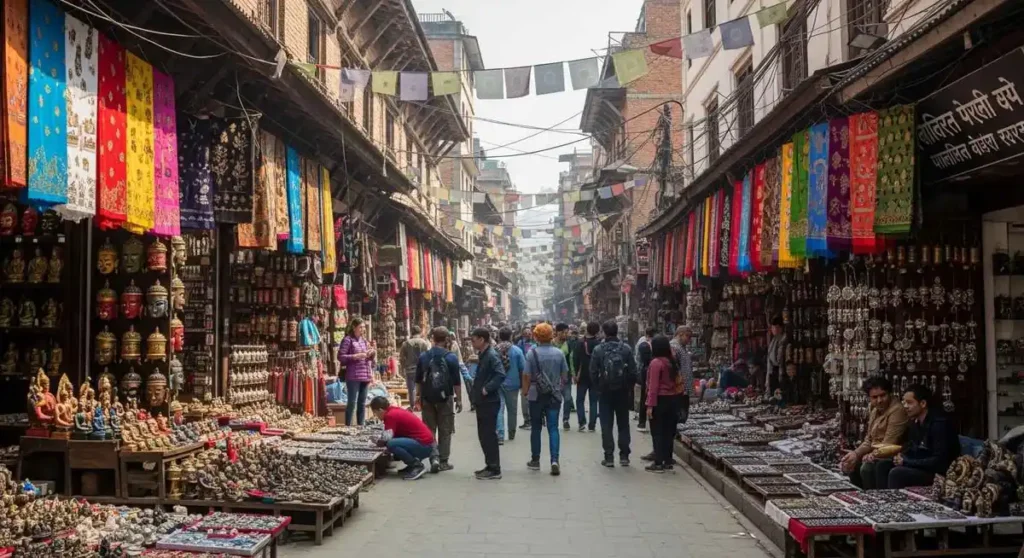
Walking through Thamel in Kathmandu, you step into a lively atmosphere where the area buzzes with shops, activity, and friendly smiles.
Known as a true tourist hub, it brings together shopping, local handicrafts, and traditional Nepali art.
The markets are filled with Pashmina shawls, soft textiles, and beautiful Thangka Paintings on canvas that often show intricate religious themes.
Many travelers also love Lokta Paper Products such as stationery, journals, and other decorative items that make wonderful souvenirs.
For adventure seekers, trekking gear and hiking equipment are easy to find in these markets, making it a perfect stop before heading to the mountains.
The colorful jewelry made from beads and natural materials adds to the charm.
A highlight for many visitors is the Gurkha Khukuri knife, a symbolic and practical souvenir, also known as the Gurkha Knives.
When the sun sets, the nightlife scene fills the central district with energy.
The nightlife vibe comes alive in cozy bars and welcoming restaurants, offering the perfect mix of food, music, and good company.
In the night, the lively markets transform, blending the beauty of traditional Nepali art with the joy of modern city fun.
7. Gateway to trekking & Everest logistics
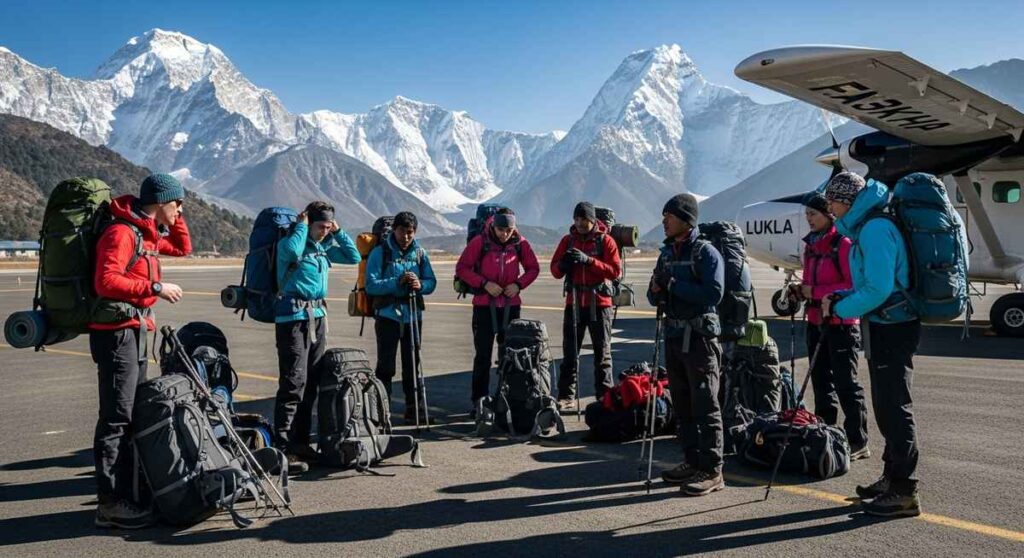
The gateway to trekking and Everest logistics begins in Kathmandu, where travelers arrange flights to Lukla, secure permits, and plan trekking services such as accommodation and support.
Options include flying into Lukla Airport or choosing a land route via Jiri or Phaplu, with reliable agencies helping with logistics, visa, passport, and entry to Sagarmatha National Park.
Starting from Kathmandu, most travelers book flights to Lukla Airport. This small airstrip, also called Tenzing-Hillary Airport, is the main gateway to the Everest region.
A good trekking agency can help with booking, permits, accommodation, and other essential services.
Carrying a valid passport, visa, and small photographs is important to secure the required fees for Sagarmatha National Park before the journey.
Some trekkers enjoy the alternative land route from Kathmandu by bus or jeep to Jiri or Phaplu, followed by a scenic multi-day trek.
On this route, you’ll find tea houses, meet friendly Sherpa people, and see culturally rich traditions within the natural beauty of the Himalayas.
For those seeking comfort and speed, domestic package trips may include a helicopter or even a shared travel option to Everest Base Camp, making the adventure both flexible and reliable.
8. Living goddess (Kumari) & dramatic festivals (Indra Jatra, Dashain, Tihar)
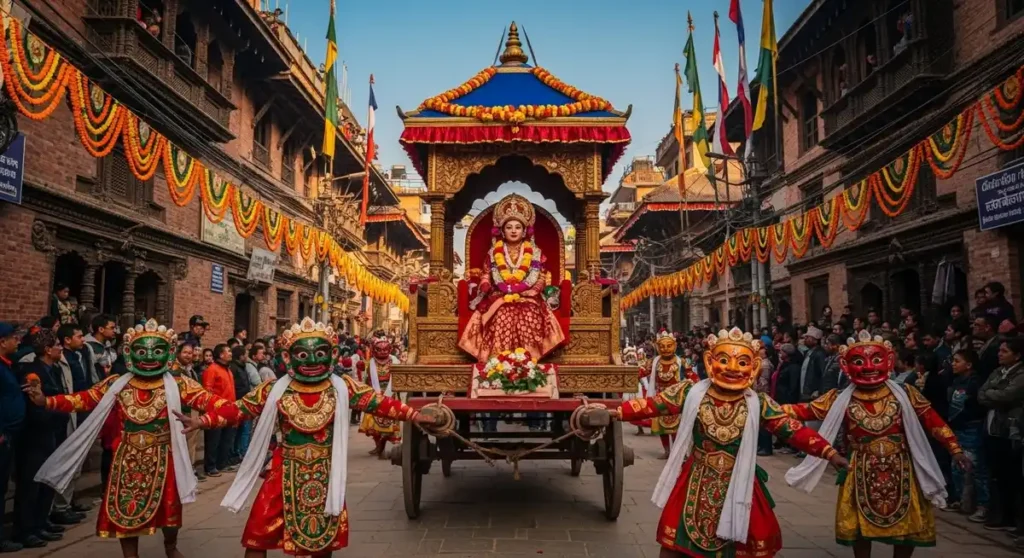
The Living Goddess (Kumari) is a young girl chosen as a living embodiment of the goddess Taleju, living in a traditional palace in Kathmandu.
Indra Jatra is a vibrant festival with masked dances, chariot processions, and blessings from the Kumari.
Dashain celebrates the victory of good over evil with family gatherings, temple rituals, and festive meals.
Tihar, the festival of lights, honors animals and family bonds with decorated homes, oil lamps, rangoli, and gift exchanges.
These festivals show the rich cultural traditions, religious spirit, and community celebrations of Nepal.
Festivals of Kathmandu
Kathmandu hosts many cultural festivals throughout the year. People come together to enjoy rituals, music, and the community spirit.
The celebrations are rooted in religious traditions and showcase the beauty of festivities. Visitors can join cultural events responsibly while appreciating local customs.
Dashain and Tihar
In September and October, Nepal celebrates Dashain, a major Hindu festival. Families gather, worship, and exchange blessings while enjoying festive meals.
Temples are beautifully decorated, and people receive tika and jamara made of barley grass.
Tihar in November is the festival of lights. It honors animals such as crows, dogs, and cows, highlighting their role in mythology and life.
Homes are decorated with oil lamps and rangoli in colorful patterns, and gifts are exchanged among family members, strengthening bonds.
Indra Jatra and the Living Goddess
Indra Jatra takes place in September and lasts a week long. It celebrates Lord Indra, the god of rain and harvest, with masked dances, chariot processions, and music at Kathmandu Durbar Square.
The Kumari, a pre-pubescent girl, is a Living Goddess and a chosen embodiment of Goddess Taleju.
She resides in the Kumari Ghar, a traditional palace, and her public appearances bring blessings and joy to the community.
Festivals include processions, sibling rituals like Bhai Tika, decorations, and cultural highlights featuring demons like Lakhey, elephant-like PuluKisi, and masks of deity Bhairav.
The events emphasize community celebration, religious spirit, and the rich traditions of the Newar community.
9. Traditional Newar arts & architecture — wood carving, metalwork, pagoda temples

In the Kathmandu Valley of Nepal, the Newar people created a unique architecture known as Newa style.
It is an indigenous form that shows strong craftsmanship in wood carving, metalwork, and pagoda designs.
The cultural and historical development of the valley is seen in every temple, stupa, shikhara, and chaitya. These structures reflect art, religion, and daily life, shaped across centuries.
The residential houses, monastic courtyards like baha and bahi, and palaces in the Durbar Squares of Kathmandu, Lalitpur, and Bhaktapur show harmonious integration of city planning.
With fine brick work and wood carving, the royal palace complexes stand as living heritage of the Malla Dynasty.
Famous Nepalese architects like Arniko carried this architectural style beyond borders, influencing India, China, Indochina, Japan, and Southeast Asian regions.
The Pagoda-style temples are most admired. Their multi-tiered roofs, rising into a pinnacle or gajur with triangle, kalasha, vase, and lotus base, form sacred designs often linked to a square mandala.
Temples like Pashupatinath, Changunarayan, Nayatapola, Dattatraya, Kasthamandap, and Taleju reflect both Hinduism and Buddhism.
Inside, lost-wax casting of statues, tympanums, and windows like the Peacock Window reveal intricate artistic prowess.
With influences from Tibetan, Chinese, and even Bhutanese traditions, Newar architecture holds deep symbolism.
Each temple, monastery, and Dharamsala is not just a building, but a harmony of history, language, traditions, and cultural identity.
The skyline of the valley shines with pagoda temples, showing how Newari craftsmanship blends heritage with timeless beauty.
10. Tea-houses, cafes & creative scene — UNESCO City of Film & Jazzmandu festival
Walking through Kathmandu, you quickly feel its vibrant atmosphere. The tea-houses and cafes are more than places to sip tea or coffee — they are central to locals, tourists, and the social life of the city.
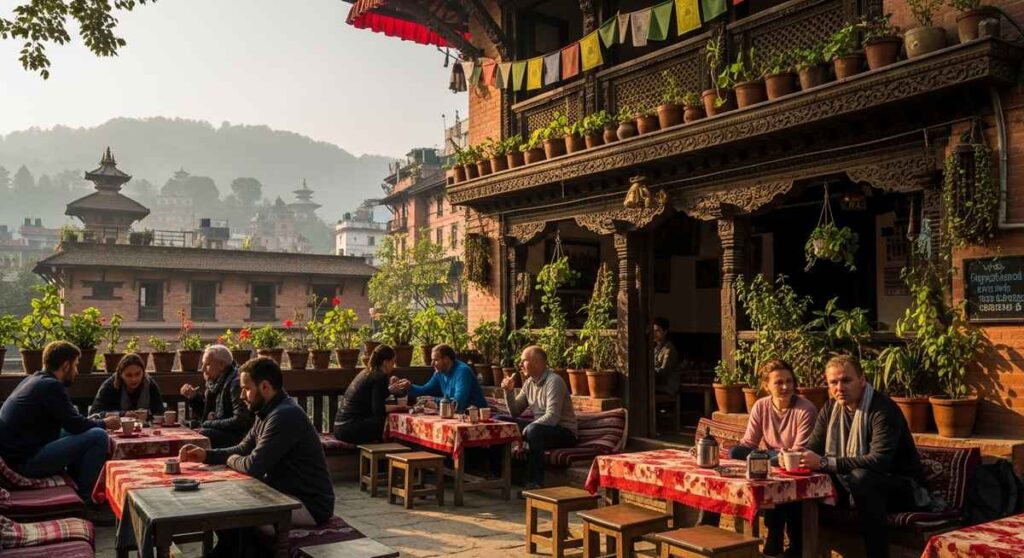
Each tea-house and cafe adds to a thriving creative scene, where people come together, share ideas, and enjoy the culture.
The Kathmandu Valley was designated a UNESCO World Heritage site in 1979, highlighting its rich historical and cultural significance.
Walking through Durbar Squares lets you explore historical sites while joining activities such as hiking.
At the same time, the city is also recognized as a UNESCO City of Film, with a designation that celebrates cinematic arts and modern cultural events.
These events create a creative landscape that feels truly distinct and engaging.
Adding to this charm, the annual Jazzmandu Festival is a major jazz music event. It brings visitors from near and far, enriching the cultural offerings of the city.
The sounds of jazz filling the streets during the festival make it a popular time to be in Kathmandu, showing how creative energy flows between its historical treasures and modern events.
11. Photography & cultural immersion—markets, rituals, sunsets from hilltop stupas
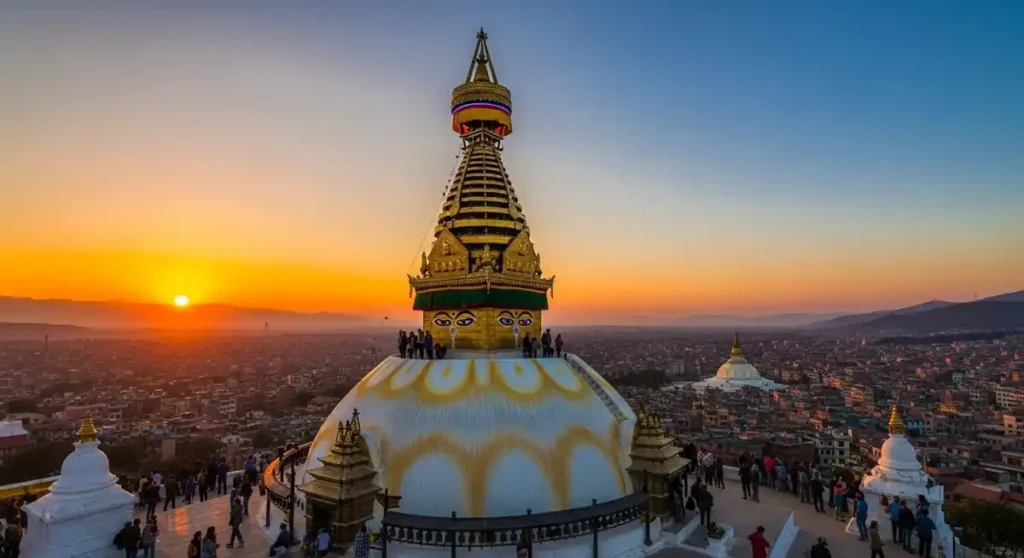
A journey through Kathmandu, Nepal is a chance to combine photography with cultural immersion.
On a photography tour, guided by a professional guide or local guides, travelers can learn how to capture emotions, tell stories, and notice fine cultural details.
With guidance on angles and lighting conditions, each frame becomes part of a larger visual narrative.
From the world’s highest peaks to a carved window, the photographic possibilities feel endless and full of inspiration.
Exploring the vibrant Tibetan markets and bustling streets opens a window into local life.
The colorful Tibetan markets glow with energy, while visits to significant religious sites like the Pashupatinath Temple highlight the depth of Buddhist traditions, symbolism, and spiritual significance.
At the Buddhist stupa Swayambhunath, known as the Monkey Temple, travelers experience the stunning light of the golden hour across the valley.
Witnessing sacred rituals and spiritual ceremonies at these sites reveals the beauty of daily life, while the peaceful hilltop stupa sunsets offer moments that stay with you long after the journey.
12. Accessibility & infrastructure for tourists — airport, hotels, guides

Kathmandu offers strong tourist accessibility with well-planned infrastructure.
Tribhuvan International Airport provides assistance and priority queues, while hotels follow disability-friendly regulations and travel companies design tailor-made experiences.
The Nepal Tourism Board also runs a staffed information center to guide travelers.
Airport Accessibility
At Tribhuvan International Airport (TIA), priority queues support elderly, pregnant, and physically challenged individuals.
Passengers can also get assistance by contacting their airline in advance.
A staffed information center by the Nepal Tourism Board shares guidance on facilities, public transport, and nearby accommodation, making travel smooth for every tourist.
Hotel Accessibility
Hotels in Kathmandu and Thamel provide many accessible options. Star-rated establishments follow regulations that include disability-friendly features such as toilets, accessible rooms, and ramps for wheelchairs.
Platforms like Tripadvisor and Responsible Travel highlight specialized holiday packages and accessible stays, helping travelers enjoy a seamless tourism experience.
Guide Services & Information
Companies like Responsible Travel create tailor-made travel plans with route mapping, elevator locations, and step-avoidance strategies.
Many Nepali people are naturally helpful and go the extra mile to accommodate tourists with mobility needs.
With trustworthy guides, chosen through recommendations and simple screening, visitors can enjoy friendly, personalized, and professional support throughout their journey.
What is Kathmandu Famous for Food
Kathmandu is famous for its rich food culture, where traditional Nepali dishes like Dal Bhat Tarkari, Momos, Newari Bara, Juju Dhau, and Sekuwa shine alongside sweet treats such as Gudpak.
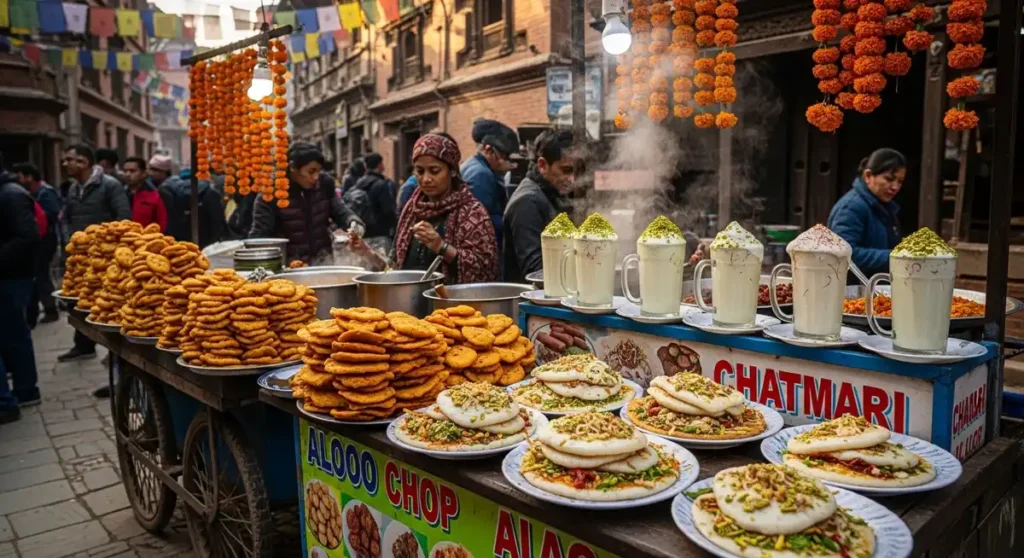
Street delights like Chatamari, Thukpa, and Aloo Chop also make the capital valley a true food paradise.
Kathmandu’s Famous Foods
Dal Bhat Tarkari
The heart of Nepali cuisine, Dal Bhat Tarkari is a wholesome meal of steamed rice, flavorful lentil soup, and spiced vegetables. It is enjoyed daily across the valley and shows the true essence of Nepalese culture.
Momos
Loved by locals and travelers alike, Momos are soft dumplings with meat, vegetables, or cheese fillings. Served steamed or fried, they come with tangy tomato chutney and are found everywhere in Kathmandu.
Newari Specialties
From the Newari community come unique dishes like Bara, a lentil patty often topped with an egg, and Juju Dhau, the creamy buffalo milk yogurt also called the “King of Yogurt.” These are true cultural treasures.
Sekuwa
Sekuwa is marinated meat—often goat, mutton, chicken, or pork—grilled on charcoal with herbs and spices. The smoky aroma and juicy taste make it a beloved street food and festival favorite.
Dhindo
Made with millet, buckwheat, or barley, Dhindo is a warm, filling porridge that can be enjoyed as a substitute for rice. It’s a traditional Nepalese comfort food.
Gudpak
For those with a sweet tooth, Gudpak is a delightful delicacy. Prepared with khuwa, ghee, sugar, and nuts, it has a fudgy, caramelized texture that locals treasure as part of their sweets and snacks.
Conclusion
Kathmandu is famous for its iconic temples, UNESCO World Heritage Sites, vibrant culture, spiritual traditions, lively festivals, and unique Newar heritage.
It is the cultural and spiritual capital of Nepal, offering rich history, artistic beauty, and warm hospitality.
Walking through Kathmandu feels like stepping into a living story. The bustling markets, Durbar Squares, and iconic temples such as Swayambhunath and Pashupatinath are treasures of Nepal’s history.
The UNESCO World Heritage Sites bring to life the traditions, religious rituals, and festivals that make the city a perfect starting point for any trip to Nepal.
The beauty of Kathmandu is how ancient and modern life blend together. From historic palaces and artistic works like wood carving and thangka painting, to the joy of local food and the hospitality of residents, every visit leaves a timeless memory.
The capital is also a spiritual home for Hindu and Buddhist pilgrimage, while being a lively economic and administrative hub that attracts tourists worldwide.
Here, the charm of the mountains, the vibrant atmosphere, and the unique Newar culture create an experience that is both deeply cultural and warmly welcoming.
It is more than just a destination — it is a place where every moment feels rich, lively, and unforgettable.
Frequently Asked Questions
What is Kathmandu best known for?
Kathmandu is best known for its ancient temples, stupas, and palaces that are part of UNESCO World Heritage Sites. It is a cultural hub where Hindu and Buddhist traditions meet. The city is also called the gateway to the Himalayas, making it a starting point for treks and mountain adventures.
What is famous in Kathmandu to buy?
Kathmandu is famous for Pashmina shawls, handmade jewelry, Lokta paper products, and Thangka paintings. Many visitors also buy trekking gear, Gurkha khukuri knives, and colorful handicrafts from Thamel markets. These items reflect the city’s art, culture, and traditions.
Why do people go to Kathmandu?
People go to Kathmandu to see its sacred temples, lively squares, and rich culture. Many come for trekking in the Himalayas, including Everest expeditions. Visitors also enjoy local food, festivals, and the chance to experience both city life and mountain landscapes.
Do and don’ts in Kathmandu?
In Kathmandu, do visit temples, enjoy local food, and respect traditions. Dress modestly, greet people with “Namaste,” and support local markets. Don’t point at religious objects, enter temples with shoes on, or disrespect local customs. Being polite and mindful makes the trip better.
Is Kathmandu cheap or expensive?
Kathmandu is mostly affordable compared to many cities. Street food, local transport, and budget stays are cheap. At the same time, luxury hotels, fine dining, and imported goods can be costly. This mix makes it easy for travelers of all budgets to enjoy the city.
Disclaimer
The content on traveldrizzle.com is for informational purposes only. While we strive for accuracy, details may change. Always verify before travel.
